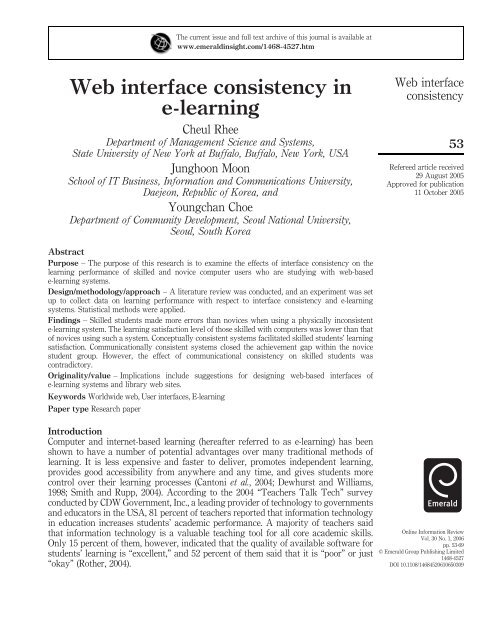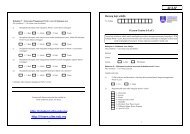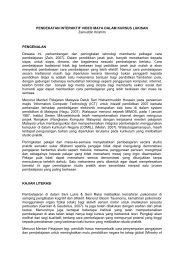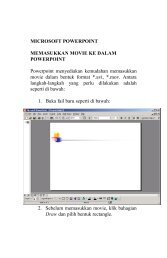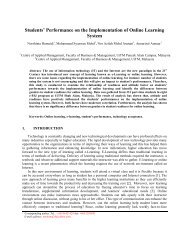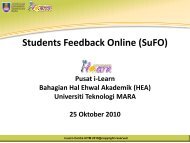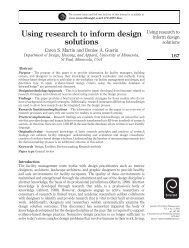Web interface consistency in e-learning - i-Learn Portal â UiTM e ...
Web interface consistency in e-learning - i-Learn Portal â UiTM e ...
Web interface consistency in e-learning - i-Learn Portal â UiTM e ...
- No tags were found...
You also want an ePaper? Increase the reach of your titles
YUMPU automatically turns print PDFs into web optimized ePapers that Google loves.
The current issue and full text archive of this journal is available atwww.emerald<strong>in</strong>sight.com/1468-4527.htm<strong>Web</strong> <strong><strong>in</strong>terface</strong> <strong>consistency</strong> <strong>in</strong>e-learn<strong>in</strong>gCheul RheeDepartment of Management Science and Systems,State University of New York at Buffalo, Buffalo, New York, USAJunghoon MoonSchool of IT Bus<strong>in</strong>ess, Information and Communications University,Daejeon, Republic of Korea, andYoungchan ChoeDepartment of Community Development, Seoul National University,Seoul, South Korea<strong>Web</strong> <strong><strong>in</strong>terface</strong><strong>consistency</strong>53Refereed article received29 August 2005Approved for publication11 October 2005AbstractPurpose – The purpose of this research is to exam<strong>in</strong>e the effects of <strong><strong>in</strong>terface</strong> <strong>consistency</strong> on thelearn<strong>in</strong>g performance of skilled and novice computer users who are study<strong>in</strong>g with web-basede-learn<strong>in</strong>g systems.Design/methodology/approach – A literature review was conducted, and an experiment was setup to collect data on learn<strong>in</strong>g performance with respect to <strong><strong>in</strong>terface</strong> <strong>consistency</strong> and e-learn<strong>in</strong>gsystems. Statistical methods were applied.F<strong>in</strong>d<strong>in</strong>gs – Skilled students made more errors than novices when us<strong>in</strong>g a physically <strong>in</strong>consistente-learn<strong>in</strong>g system. The learn<strong>in</strong>g satisfaction level of those skilled with computers was lower than thatof novices us<strong>in</strong>g such a system. Conceptually consistent systems facilitated skilled students’ learn<strong>in</strong>gsatisfaction. Communicationally consistent systems closed the achievement gap with<strong>in</strong> the novicestudent group. However, the effect of communicational <strong>consistency</strong> on skilled students wascontradictory.Orig<strong>in</strong>ality/value – Implications <strong>in</strong>clude suggestions for design<strong>in</strong>g web-based <strong><strong>in</strong>terface</strong>s ofe-learn<strong>in</strong>g systems and library web sites.Keywords Worldwide web, User <strong><strong>in</strong>terface</strong>s, E-learn<strong>in</strong>gPaper type Research paperIntroductionComputer and <strong>in</strong>ternet-based learn<strong>in</strong>g (hereafter referred to as e-learn<strong>in</strong>g) has beenshown to have a number of potential advantages over many traditional methods oflearn<strong>in</strong>g. It is less expensive and faster to deliver, promotes <strong>in</strong>dependent learn<strong>in</strong>g,provides good accessibility from anywhere and any time, and gives students morecontrol over their learn<strong>in</strong>g processes (Cantoni et al., 2004; Dewhurst and Williams,1998; Smith and Rupp, 2004). Accord<strong>in</strong>g to the 2004 “Teachers Talk Tech” surveyconducted by CDW Government, Inc., a lead<strong>in</strong>g provider of technology to governmentsand educators <strong>in</strong> the USA, 81 percent of teachers reported that <strong>in</strong>formation technology<strong>in</strong> education <strong>in</strong>creases students’ academic performance. A majority of teachers saidthat <strong>in</strong>formation technology is a valuable teach<strong>in</strong>g tool for all core academic skills.Only 15 percent of them, however, <strong>in</strong>dicated that the quality of available software forstudents’ learn<strong>in</strong>g is “excellent,” and 52 percent of them said that it is “poor” or just“okay” (Rother, 2004).Onl<strong>in</strong>e Information ReviewVol. 30 No. 1, 2006pp. 53-69q Emerald Group Publish<strong>in</strong>g Limited1468-4527DOI 10.1108/14684520610650309
OIR30,154Literature <strong>in</strong> the area of e-learn<strong>in</strong>g po<strong>in</strong>ts out that the quality of educationalsoftware is significantly related to its <strong><strong>in</strong>terface</strong> quality (e.g. Buzhardt et al., 2005;Cantoni et al., 2004; Chu and Chan, 1998; H<strong>in</strong>ostroza and Mellar, 2001). The <strong><strong>in</strong>terface</strong>quality of educational software, moreover, has a serious impact on the learn<strong>in</strong>goutcome of the student (Gauss and Urbas, 2003; Jonassen and Wang, 1993). Crowtheret al. (2004) argue that the impact of a poor <strong><strong>in</strong>terface</strong> design <strong>in</strong> education is more seriousthan <strong>in</strong> bus<strong>in</strong>ess. It impairs a student’s overall motivation, as well as their learn<strong>in</strong>gperformance, and has serious moral and ethical implications. In essence, <strong>in</strong>teractivitybetween student and <strong><strong>in</strong>terface</strong> is considered the most important aspect <strong>in</strong> recent studieson how to improve quality of education through e-learn<strong>in</strong>g (Cantoni et al., 2004; Chou,2003; Ellis and Blashki, 2004; Gauss and Urbas, 2003).The concept of <strong>in</strong>teractivity of <strong><strong>in</strong>terface</strong> was derived from the field of <strong>in</strong>formationsystems, and it was usually considered an <strong>in</strong>fluential factor <strong>in</strong> improv<strong>in</strong>g bus<strong>in</strong>ess website quality (Chou, 2003). In the area of e-learn<strong>in</strong>g, however, <strong>in</strong>teractivity plays a crucialrole <strong>in</strong> knowledge acquisition and is counted as a core feature for e-students (Cantoniet al., 2004; Chou, 2003). To date, there are very few studies deal<strong>in</strong>g with <strong>in</strong>teractivityissues <strong>in</strong> e-learn<strong>in</strong>g. Some of them have tried to establish guidel<strong>in</strong>es or evaluation toolsfor <strong>in</strong>teractivity of <strong><strong>in</strong>terface</strong> <strong>in</strong> e-learn<strong>in</strong>g, but have not provided relevant empiricalverifications.A literature review <strong>in</strong> <strong>in</strong>formation systems found that <strong>in</strong>teractivity of <strong><strong>in</strong>terface</strong> isassociated with issues of <strong><strong>in</strong>terface</strong> <strong>consistency</strong> among various aspects related to<strong><strong>in</strong>terface</strong> design (Grud<strong>in</strong>, 1992; L<strong>in</strong> et al., 1997; Ozok and Salvendy, 2003, 2004). Thebottom l<strong>in</strong>e of <strong><strong>in</strong>terface</strong> <strong>consistency</strong> theory is that <strong>in</strong>creas<strong>in</strong>g the <strong>consistency</strong> levels of<strong><strong>in</strong>terface</strong> results <strong>in</strong> a significant decrease of error rates <strong>in</strong> computer and web-basedtasks (Ozok and Salvendy, 2004), and Ozok and Salvendy (2003) po<strong>in</strong>ted out that<strong><strong>in</strong>terface</strong> <strong>consistency</strong> is concerned with <strong>in</strong>teraction between the user and the <strong><strong>in</strong>terface</strong>.In the field of education, Gerrett et al. (1998) argued that ma<strong>in</strong>ta<strong>in</strong><strong>in</strong>g <strong><strong>in</strong>terface</strong><strong>consistency</strong> helps students to easily become familiar with <strong><strong>in</strong>terface</strong> functionality andstyles of <strong>in</strong>teraction. Chu and Chan (1998) stressed the importance of <strong><strong>in</strong>terface</strong><strong>consistency</strong> for successful design of <strong>in</strong>teractive <strong><strong>in</strong>terface</strong>s for students, show<strong>in</strong>g that aconsistent <strong><strong>in</strong>terface</strong> <strong>in</strong> educational software behaves <strong>in</strong> a predictable fashion tostudents. Several studies, such as those conducted by Crowley et al. (2002), Gustafson(2004), and Lee et al. (2005) also emphasised the importance of <strong><strong>in</strong>terface</strong> <strong>consistency</strong> <strong>in</strong>e-learn<strong>in</strong>g; however most of them are case studies or theoretical research for education.A literature review for this research could not f<strong>in</strong>d any empirical studies deal<strong>in</strong>g withthe effect of <strong><strong>in</strong>terface</strong> <strong>consistency</strong> or <strong>in</strong><strong>consistency</strong> on learn<strong>in</strong>g processes for e-learn<strong>in</strong>g.Accord<strong>in</strong>gly, this study applies <strong><strong>in</strong>terface</strong> <strong>consistency</strong> theory to e-learn<strong>in</strong>g systemsto exam<strong>in</strong>e the effect of <strong><strong>in</strong>terface</strong> <strong>consistency</strong> on learn<strong>in</strong>g so that relevant guidel<strong>in</strong>escan be established to enhance <strong>in</strong>teractivity of e-learn<strong>in</strong>g systems <strong>in</strong> the future.Furthermore, this study will deal with the issue of the “digital divide” with respect toe-learn<strong>in</strong>g. Government reports and academic research provide critical evidence thatthere is a serious gap between the digital “haves” and “have-nots”, and that the gap isstill grow<strong>in</strong>g (Drori and Jang, 2003; Jackson et al., 2004; Prieger, 2003; Wilson et al.,2003). We believe that e-learn<strong>in</strong>g has to take account of this, and we will explore theeffect of <strong><strong>in</strong>terface</strong> <strong>consistency</strong> for e-learn<strong>in</strong>g on haves and have-nots. This attempt willmake e-learn<strong>in</strong>g systems able to be customised for comput<strong>in</strong>g novices <strong>in</strong> the future,which is a way to bridge the digital gap <strong>in</strong> education equity.
Research questionsA literature review found that poor quality of an e-learn<strong>in</strong>g system must be related topoor <strong>in</strong>teractivity of the <strong><strong>in</strong>terface</strong>. In approach<strong>in</strong>g the issue of <strong>in</strong>teractivity <strong>in</strong>e-learn<strong>in</strong>g, we found that <strong><strong>in</strong>terface</strong> <strong>consistency</strong> theory can be a key tool to improve<strong>in</strong>teractivity <strong>in</strong> e-learn<strong>in</strong>g. Thus, this study will conduct an experiment by apply<strong>in</strong>g<strong><strong>in</strong>terface</strong> <strong>consistency</strong> to e-learn<strong>in</strong>g systems.This study develops research questions to accomplish the goals mentioned earlier.The first ma<strong>in</strong> research question of this study is: what is the effect of <strong>consistency</strong> of<strong><strong>in</strong>terface</strong> on learn<strong>in</strong>g? Second, with regard to the effect of <strong>consistency</strong>, are there anydifferences between a group of students who are skilled <strong>in</strong> computer use and anothergroup composed of novices? The f<strong>in</strong>d<strong>in</strong>gs from the two research questions will provideboth researchers and practitioners, <strong>in</strong>clud<strong>in</strong>g educators and librarians, with newcriteria for <strong><strong>in</strong>terface</strong> design issues <strong>in</strong> the area of e-learn<strong>in</strong>g.Figure 1 represents a conceptual model of this study, and the model will beexpla<strong>in</strong>ed <strong>in</strong> detail <strong>in</strong> the next section.<strong>Web</strong> <strong><strong>in</strong>terface</strong><strong>consistency</strong>55Interface <strong>consistency</strong>BackgroundInterface <strong>consistency</strong> has occasionally been studied <strong>in</strong> terms of computer science andmanagement <strong>in</strong>formation systems. Regard<strong>in</strong>g management <strong>in</strong>formation systems,<strong>consistency</strong> has been assumed to enhance the worker’s ability to transfer skills ga<strong>in</strong>ed<strong>in</strong> us<strong>in</strong>g one system to another. Accord<strong>in</strong>g to Nielsen (2001), <strong>consistency</strong> improves theworker’s productivity by lead<strong>in</strong>g to higher throughput and fewer errors because theworker can predict what the system will do <strong>in</strong> any given situation and because theworker can rely on the “rules”. This idea was conceived <strong>in</strong> the 1980 s but not frequentlymentioned until GUI (Graphical User Interface) began to be widely used on computers.S<strong>in</strong>ce the late 1990 s it has been used to evaluate the effectiveness of <strong>in</strong>formationsystems <strong>in</strong> workplaces, and a couple of empirical studies found that it is related toworkers’ job performance (e.g. Ozok and Salvendy, 2000; Ozok and Salvendy, 2003;Satz<strong>in</strong>ger and Olfman, 1998).Satz<strong>in</strong>ger and Olfman (1998), who found that <strong>consistency</strong> is related to jobperformance (e.g. task accuracy, task time), brought up a relationship between<strong><strong>in</strong>terface</strong> <strong>consistency</strong> and human learn<strong>in</strong>g processes. They mentioned that consistentFigure 1.Conceptual model of thisstudy
OIR30,156user <strong><strong>in</strong>terface</strong> probably facilitates transfer of learn<strong>in</strong>g, and also po<strong>in</strong>ted out that veryfew studies have <strong>in</strong>vestigated the effects of <strong><strong>in</strong>terface</strong> <strong>consistency</strong> on learn<strong>in</strong>g. Theirstudy provides a good rationale for research on e-learn<strong>in</strong>g associated with <strong><strong>in</strong>terface</strong><strong>consistency</strong>. The effects of <strong><strong>in</strong>terface</strong> <strong>consistency</strong> on learn<strong>in</strong>g will be identified <strong>in</strong> thisstudy through an experiment apply<strong>in</strong>g it to e-learn<strong>in</strong>g systems.Three-dimensional model of <strong><strong>in</strong>terface</strong> <strong>consistency</strong>Interface <strong>consistency</strong> has been studied for more than a decade, and thus there areseveral perspectives on it. However, most literature showed that the <strong>consistency</strong> levelof an <strong><strong>in</strong>terface</strong> is related to work performance with PC-based and web-based computertasks (Ozok and Salvendy, 2004). For detailed descriptions, refer to the literaturereview sections of Ozok and Salvendy (2000) and Satz<strong>in</strong>ger and Olfman (1998).There are several views on <strong><strong>in</strong>terface</strong> <strong>consistency</strong>, but <strong>in</strong> some circumstances it isvery difficult to def<strong>in</strong>e <strong>consistency</strong> (Grud<strong>in</strong>, 1992). Grud<strong>in</strong> (1989) emphasised that evena group of 15 experts were unable to produce a def<strong>in</strong>ition of <strong>consistency</strong> dur<strong>in</strong>g a twoday workshop and <strong>in</strong> most cases there is no absolute rule of <strong><strong>in</strong>terface</strong> <strong>consistency</strong>—it isperceived by the user. On the basis of a literature review, follow<strong>in</strong>g Ozok and Salvendy(2000) and Satz<strong>in</strong>ger and Olfman (1998), this study def<strong>in</strong>es <strong><strong>in</strong>terface</strong> <strong>consistency</strong> asuser-perceived multidimensional attributes of an <strong><strong>in</strong>terface</strong> which <strong>in</strong>clude the similarityof features, functions, and position<strong>in</strong>g across a system and between systems.Grud<strong>in</strong> (1989) divided <strong><strong>in</strong>terface</strong> <strong>consistency</strong> <strong>in</strong>to <strong>in</strong>ternal <strong><strong>in</strong>terface</strong> <strong>consistency</strong> andexternal <strong><strong>in</strong>terface</strong> <strong>consistency</strong>. Internal <strong><strong>in</strong>terface</strong> <strong>consistency</strong> refers to <strong>consistency</strong>with<strong>in</strong> a task or a system and external <strong><strong>in</strong>terface</strong> <strong>consistency</strong> means <strong>consistency</strong> amongdifferent tasks or systems. Ozok and Salvendy (2000) dealt with the <strong>in</strong>ternal<strong>consistency</strong> more carefully and classified it <strong>in</strong>to three sub-types: conceptual<strong>consistency</strong>, communicational <strong>consistency</strong>, and physical <strong>consistency</strong>. Based on thisclassification, they established the three-dimensional model of <strong><strong>in</strong>terface</strong> <strong>consistency</strong> asshown <strong>in</strong> Figure 2.Physical <strong>consistency</strong> is the <strong>consistency</strong> of the graphical appearance or the visualcharacteristics of an <strong><strong>in</strong>terface</strong> feature. It <strong>in</strong>dicates that the features are supposed to beconsistent with the recognition of users. Users, for example, may deal with menus,check boxes, radio buttons, combo boxes, screen buttons, and so forth (Ozok andSalvendy, 2000, 2004). Appendix, Figure A1, illustrates an example of physical<strong>in</strong><strong>consistency</strong>. Those two pages exist on the same e-learn<strong>in</strong>g system. However,different font types, font sizes, and font colours were used between two pages. Also, thespac<strong>in</strong>g of characters is not consistent. Moreover, menu items on the top of these pagesalso look <strong>in</strong>consistent and confus<strong>in</strong>g.Communicational <strong>consistency</strong> is the <strong>consistency</strong> of the <strong>in</strong>put and the output of the<strong><strong>in</strong>terface</strong>. It deals with how the user <strong>in</strong>teracts with the computer <strong><strong>in</strong>terface</strong> and whetherthe means of <strong>in</strong>teraction are consistent for fulfill<strong>in</strong>g the same or similar tasks. The<strong>in</strong>teraction is usually <strong>in</strong> the form of the user’s retrieval of <strong>in</strong>formation from the<strong><strong>in</strong>terface</strong> (Ozok and Salvendy, 2000, 2004). Appendix, Figure A2, illustrates an exampleof communicational <strong>in</strong><strong>consistency</strong>. Those two pages exist on the same library<strong>in</strong>formation system, but the overall location of web features on the <strong><strong>in</strong>terface</strong>s is<strong>in</strong>consistent. For <strong>in</strong>stance, to access the next list on the web page, students will need touse the scroll bar on a page, but on another page, they are supposed to use hyperl<strong>in</strong>ks
<strong>Web</strong> <strong><strong>in</strong>terface</strong><strong>consistency</strong>57Figure 2.Three-dimensional modelof <strong><strong>in</strong>terface</strong> <strong>consistency</strong>to access it. Also, the location of the menu bar differed between two pages, which canbe confus<strong>in</strong>g.Conceptual <strong>consistency</strong> is the <strong>consistency</strong> of metaphor applied to an <strong><strong>in</strong>terface</strong>feature or an action that is embodied with<strong>in</strong> a feature. Frequent and <strong>in</strong>consistent use ofsynonyms, <strong>in</strong>stead of us<strong>in</strong>g the same words for the same items, is unhelpful. Leav<strong>in</strong>gsometh<strong>in</strong>g to students’ imag<strong>in</strong>ation and <strong>in</strong>terpretation due to lack of explicitness is alsoregarded as conceptual <strong>in</strong><strong>consistency</strong> (Grud<strong>in</strong>, 1989; Ozok and Salvendy, 2000).Appendix, Figure A3, illustrates an example of conceptual <strong>in</strong><strong>consistency</strong>. The firstpage looks conceptually consistent with<strong>in</strong> the page, but several conceptual<strong>in</strong>consistencies are found between the two pages. Several terms were changed,mak<strong>in</strong>g it difficult for students to understand that they refer to the same th<strong>in</strong>gs:, e.g.“blog/weblog” and “bloggers/blog users/users” were used <strong>in</strong>consistently. Theabbreviation “BSP” was not clearly def<strong>in</strong>ed and was randomly used across thosepages. Students will be bewildered by mixed use of the terms “e-community/<strong>in</strong>ternet
OIR30,158community/onl<strong>in</strong>e community”. Several ambiguous sentences are found on the secondpage, <strong>in</strong>clud<strong>in</strong>g frequent use of synonyms and lack of explicitness.This study follows Ozok and Salvendy’s (2000) view of <strong><strong>in</strong>terface</strong> <strong>consistency</strong> andtheir three-dimensional model of <strong><strong>in</strong>terface</strong> <strong>consistency</strong> (see Figure 2) because thismodel has been validated through appropriate quantitative methods (e.g. Ozok andSalvendy, 2000, 2003, 2004) and because the model was recently designed forweb-based systems. McIntyre and Wolff (1998) mention that the world wide web is auniversally accepted format that can be accessed world-wide easily via <strong>in</strong>expensivecomputer systems for e-learn<strong>in</strong>g. Thus, this study asserts that Ozok and Salvendy’s(2000) three-dimensional model is a relevant tool to demonstrate current e-learn<strong>in</strong>gsystems with respect to <strong><strong>in</strong>terface</strong> <strong>consistency</strong>.MethodImplementation of e-learn<strong>in</strong>g systems for the experimentIn order to exam<strong>in</strong>e the effect of <strong><strong>in</strong>terface</strong> <strong>consistency</strong> on learn<strong>in</strong>g via an e-learn<strong>in</strong>gsystem, the authors conducted an experiment. The first step <strong>in</strong> sett<strong>in</strong>g up theexperiment was to develop four different types of web-based e-learn<strong>in</strong>g systems (seeTable I). The e-learn<strong>in</strong>g systems were developed based on Ozok and Salvendy’s (2000)idea. Their experiment focused on workers’ task performance, but the experiment <strong>in</strong>this study was oriented to learn<strong>in</strong>g a topic through the systems. All systems for thisexperiment dealt with the same topic for learn<strong>in</strong>g: technology adaptation <strong>in</strong> the area ofagriculture. That is, all students were supposed to learn the same content and the sameamount of <strong>in</strong>formation on each topic. Each system was composed of about ten webpages deal<strong>in</strong>g with the topic written <strong>in</strong> Korean, the native language of the participants.F<strong>in</strong>ally, four different types of e-learn<strong>in</strong>g systems were completed, and the differencesbetween the four systems are illustrated <strong>in</strong> Table I.Type I is a standard system which has high <strong><strong>in</strong>terface</strong> <strong>consistency</strong>. Interfaces <strong>in</strong>Type I were designed to be physically, communicationally, and conceptuallyconsistent on the basis of Ozok and Salvendy’s (2000), (2004) work. The text and labelsizes, colour, background colour and overall text format were standardised as <strong>in</strong>dicated<strong>in</strong> Ozok and Salvendy (2000).Type II was designed to be physically <strong>in</strong>consistent. Different <strong>in</strong>consistent colourswere used for labels, background, and text characters with<strong>in</strong> or between pages. Thesizes of the features on pages, such as characters, buttons, combo boxes, radio buttons,etc. were made <strong>in</strong>consistent as well. The spac<strong>in</strong>g of characters was also manipulated tobe <strong>in</strong>consistent throughout the web <strong><strong>in</strong>terface</strong>.Type III was designed to be communicationally <strong>in</strong>consistent. As <strong>in</strong>dicated by Ozokand Salvendy (2000), the overall location of the text, pictures, and other features on the<strong><strong>in</strong>terface</strong>s was made <strong>in</strong>consistent. For example, <strong>in</strong> some pages, students can move on toE-learn<strong>in</strong>g system typePhysical<strong>consistency</strong>Communicational<strong>consistency</strong>Conceptual<strong>consistency</strong>Table I.Experimentalmanipulations ofe-learn<strong>in</strong>g systemsType I High High HighType II Low High HighType III High Low HighType IV High High Low
the next paragraphs or parts by us<strong>in</strong>g the scroll bar, but on other pages <strong>in</strong> the samesystem, the students needed to click a hyperl<strong>in</strong>k to complete the same tasks <strong>in</strong>stead.Also, the locations of the buttons were <strong>in</strong>consistently arranged. On some pages, thelocations of buttons were at the bottom-right, but sometimes their locations were atbottom-centre, or <strong>in</strong> the corners. F<strong>in</strong>ally, on some other pages, students had to usehyperl<strong>in</strong>ks <strong>in</strong>stead of buttons.Type IV was made conceptually <strong>in</strong>consistent. The language of the text waschanged, mak<strong>in</strong>g it difficult for students to understand. Sometimes long paragraphswere displayed, and terms were used <strong>in</strong>consistently with<strong>in</strong> the <strong><strong>in</strong>terface</strong>. For example,<strong>in</strong> expla<strong>in</strong><strong>in</strong>g the situation of North Korea related to the agriculture <strong>in</strong>dustry, the TypeVI system sometimes used the term “North Korea”, but <strong>in</strong> some other parts it used“The Democratic People’s Republic of Korea” <strong>in</strong>stead. In the same way, synonyms ofseveral terms were used <strong>in</strong>terchangeably across the system, and mixed uses of directexpressions and metaphors also made the sentences ambiguous (Ozok and Salvendy,2000, 2004).<strong>Web</strong> <strong><strong>in</strong>terface</strong><strong>consistency</strong>59Experiment designThe goal of this experiment was to exam<strong>in</strong>e the effect of <strong><strong>in</strong>terface</strong> <strong>consistency</strong> onlearn<strong>in</strong>g, and as mentioned earlier, this study also explores differences between skilledusers and novices on the computer <strong>in</strong> learn<strong>in</strong>g through e-learn<strong>in</strong>g systems. Afterbuild<strong>in</strong>g four types of e-learn<strong>in</strong>g systems, we sought participants for this experimentand divided them <strong>in</strong>to two groups: an IT professional (skilled user) group and a novicegroup. The IT professional group subjects were composed of GIS (GeographicalInformation Systems) professionals, web adm<strong>in</strong>istrators, web designers, andknowledge workers. All members of the professional group were very skilled on thecomputer, possessed their own computers, and lived <strong>in</strong> urban areas. All of themgraduated from community college or higher. In contrast, novice group subjects werecomposed of farmers <strong>in</strong> rural areas who were not experienced computer users, andmost of them did not have their own computer. Moreover, more than half of them hadnever used computers before, and most of them (93.5 percent) graduated from highschool or lower. Table II illustrates the different profiles of each group.The members of each group were randomly divided <strong>in</strong>to four subgroups—fourprofessional subgroups and four novice subgroups. Each subgroup was assigned toProfile category Professional group Novice group(n ¼ 112) % (n ¼ 124) %Age (average) 28.9 34.2GenderMale 91 81.3 119 96Female 21 8.7 5 4Education levelHigh school or lower 0 0 116 93.5Community college 16 14.3 6 4.8College 78 69.6 2 1.6Graduate school or higher 18 16.1 0 0Household/personal computer ownership 112 100 42 33.9Table II.Profiles of the two groups
OIR30,160one of the four types of e-learn<strong>in</strong>g systems. Thus, one subgroup of professionals andone subgroup of novices were assigned to the Type I system, and so forth. In this way,each e-learn<strong>in</strong>g system was matched to two subgroups: one subgroup of professionalsand one subgroup of novices.Participants were asked to use the assigned e-learn<strong>in</strong>g system to learn abouttechnology adaptation <strong>in</strong> the area of agriculture, and also asked to answer 14 preparedquestions on the topic as quickly as possible. All studied the same topic and answeredthe same questions us<strong>in</strong>g different e-learn<strong>in</strong>g systems. To answer the questions, it wasnecessary to click buttons, use radio buttons and combo boxes, and fill out <strong>in</strong>put forms,us<strong>in</strong>g the mouse and the keyboard. <strong>Learn</strong><strong>in</strong>g times and all answers by <strong>in</strong>dividuals wererecorded for analysis. After complet<strong>in</strong>g the experiment, participants were also asked torespond to a survey on their learn<strong>in</strong>g experiences us<strong>in</strong>g the e-learn<strong>in</strong>g system. The aimof the survey was to measure satisfaction levels with the e-learn<strong>in</strong>g experiences, andthe survey form, us<strong>in</strong>g a seven-po<strong>in</strong>t Likert scale, was based on that of Ozok andSalvendy (2000).All “students” voluntarily participated <strong>in</strong> the experiment, and were advised thatthey could withdraw from participation at any time without adverse consequence.There were 112 <strong>in</strong> the professional group and 124 <strong>in</strong> the novice group as shown <strong>in</strong>Table II. Unexpectedly, 42 members of the novice group withdrew from participationdur<strong>in</strong>g the experiment. We <strong>in</strong>vestigated and found that it was because most of themfelt that us<strong>in</strong>g the keyboard and/or mouse was very difficult, or <strong>in</strong> some cases they didnot know how to use the equipment. However, there were no withdrawals from theprofessional group. This unexpected f<strong>in</strong>d<strong>in</strong>g provides further evidence of the exist<strong>in</strong>gdigital divide. We had to exclude those 42 people from the experiment and then lookedover collected data to remove unusable data. Data which conta<strong>in</strong>ed at least one miss<strong>in</strong>gvalue dur<strong>in</strong>g the experiment were removed from the analysis so that this study couldbe free from <strong>in</strong>accurate or irrelevant results. F<strong>in</strong>ally, data collected from 71 members ofthe professional group and 40 of the novice group were used for analysis.ResultsTable III illustrates descriptive statistics from the experiment conducted <strong>in</strong> this study.Accord<strong>in</strong>g to Table III, overall, the novice group spent more time on learn<strong>in</strong>g, hadlower error rates (lower percentages of wrong answers), and felt higher satisfactionwith the learn<strong>in</strong>g process through the e-learn<strong>in</strong>g system than the professional (skilleduser) group. However, the differences were not considerable.Professional group versus novice groupIn order to explore different effects of <strong><strong>in</strong>terface</strong> <strong>in</strong><strong>consistency</strong> on these two groups, weused two-tailed t-tests and found that (a ¼ 0.1):.students us<strong>in</strong>g the Type II (physically <strong>in</strong>consistent) system <strong>in</strong> the professionalgroup recorded significantly higher error rates than those us<strong>in</strong>g that system <strong>in</strong>the novice group (t ¼ 1:77, df ¼ 32); and.learn<strong>in</strong>g satisfaction levels of students us<strong>in</strong>g the Type II system <strong>in</strong> theprofessional group were significantly lower than those of students us<strong>in</strong>g thatsystem <strong>in</strong> the novice group (t ¼ 21:91, df ¼ 32).
Professional groupNovice groupn Mean SD n Mean SDOverall<strong>Learn</strong><strong>in</strong>g time 7 226.59 104.33 40 265.31 295.651Error rate 7 8.46 4.51 40 6.95 3.681Satisfaction 7 17.26 6.66 38 20.09 6.41Type I. Standard<strong>Learn</strong><strong>in</strong>g time 1 242.11 92.51 11 257.44 92.859Error rate 1 8.47 5.43 11 7.54 2.849Satisfaction 1 19.18 5.21 11 21.04 6.49Type II. Physically <strong>in</strong>consistent<strong>Learn</strong><strong>in</strong>g time 2 233 141.3 10 236.61 126.774Error rate 2 9.62 5.44 10 7.4 1.834Satisfaction 2 16.58 6.95 10 20.15 3.834Type III. Comm. <strong>in</strong>consistent<strong>Learn</strong><strong>in</strong>g time 1 223.76 74 9 368.78 595.347Error rate 1 7.11 1.36 9 6.44 5.547Satisfaction 1 17.35 7.66 9 20.33 9.667Type IV. Conceptual <strong>in</strong>consistent<strong>Learn</strong><strong>in</strong>g time 1 190.19 63.86 10 209.56 151.51Error rate 1 8 3.46 10 6.3 4.211Satisfaction 1 15.31 6.64 8 18.43 5.31<strong>Web</strong> <strong><strong>in</strong>terface</strong><strong>consistency</strong>61Table III.Descriptive statistics ofresultsWe found that if the <strong><strong>in</strong>terface</strong>s of the e-learn<strong>in</strong>g system were designed to be physically<strong>in</strong>consistent, the professional group (skilled students) will be more <strong>in</strong>fluenced by itseffect on error rate than the novice group. That is, the physically <strong>in</strong>consistent <strong><strong>in</strong>terface</strong>sof the e-learn<strong>in</strong>g system perplexed skilled students because skilled students havenumerous prior experiences us<strong>in</strong>g computers so they have expectations about featuresof the <strong><strong>in</strong>terface</strong>. They might notice a big discrepancy when they encounter theunexpected on the <strong><strong>in</strong>terface</strong>. Their learn<strong>in</strong>g processes are <strong>in</strong>terfered with andconsequently more errors <strong>in</strong> learn<strong>in</strong>g processes will occur. However, novice studentswere less <strong>in</strong>fluenced by physically <strong>in</strong>consistent <strong><strong>in</strong>terface</strong>s than skilled students werebecause novice students did not have as many preconceived ideas about the <strong><strong>in</strong>terface</strong>.
OIR30,162This disparity yielded a significant mean difference between the two groups <strong>in</strong> errorrates.Regard<strong>in</strong>g learn<strong>in</strong>g satisfaction us<strong>in</strong>g the Type II system, the satisfaction level ofthe professional group (skilled students) us<strong>in</strong>g physically <strong>in</strong>consistent <strong><strong>in</strong>terface</strong>s wasmuch lower than that of the novice group. This f<strong>in</strong>d<strong>in</strong>g could be due to the fact that thelearn<strong>in</strong>g satisfaction of skilled students is more <strong>in</strong>fluenced by physical <strong>in</strong><strong>consistency</strong>due to their prior experiences than that of the novice students.Accord<strong>in</strong>gly, these f<strong>in</strong>d<strong>in</strong>gs illustrate that skilled students are relatively moresensitive to physical <strong>in</strong><strong>consistency</strong> than novice students. However, these analyses onlypartially expla<strong>in</strong> the effects of <strong><strong>in</strong>terface</strong> <strong>consistency</strong> on e-learn<strong>in</strong>g because we simplycompared means between two different groups. Thus, mean comparisons betweensubgroups (e.g. Types I and II, Types I and III, and Types I and IV) with<strong>in</strong> each groupwill provide more valuable understand<strong>in</strong>g of the effects of <strong><strong>in</strong>terface</strong> <strong>consistency</strong>. Suchanalyses will show whether <strong><strong>in</strong>terface</strong> <strong>consistency</strong> improves learn<strong>in</strong>g performance ofsimilar or homogeneous students <strong>in</strong> the next section.Effects of <strong><strong>in</strong>terface</strong> <strong>consistency</strong> on learn<strong>in</strong>g with<strong>in</strong> each groupOn the basis of Table III, we conducted mean comparisons between subgroups with<strong>in</strong>each group. First, <strong>in</strong> the professional group, a t-test was applied to compare means(learn<strong>in</strong>g time, error rate, and satisfaction) of the Type I-use subgroup with those of theType II-use subgroup. Then, also <strong>in</strong> the professional group, another t-test was appliedto compare means of the Type I-use subgroup with those of the Type III-use subgroup.In the same way, mean comparisons between the Type I-use subgroup and the TypeIV-use subgroup <strong>in</strong> the professional group were performed. The same procedures wereapplied to subgroups <strong>in</strong> the novice group. F<strong>in</strong>ally, we hypothesised that the Type Isystem would yield shorter learn<strong>in</strong>g times, lower error rates, and higher learn<strong>in</strong>gsatisfaction than the other three systems with<strong>in</strong> each group. That is, high-<strong>consistency</strong><strong><strong>in</strong>terface</strong>s would result <strong>in</strong> improvement <strong>in</strong> learn<strong>in</strong>g processes. We found that (a ¼ 0.1,two-tailed): <strong>in</strong> the professional group, learn<strong>in</strong>g satisfaction levels of students us<strong>in</strong>g theType I (standard) system were significantly higher than those of students us<strong>in</strong>g theType IV (conceptually <strong>in</strong>consistent) system (t ¼ 1:76, df ¼ 28).There were no other significant effects of <strong><strong>in</strong>terface</strong> <strong>in</strong><strong>consistency</strong> on learn<strong>in</strong>g basedon the results from the two-tailed t-tests at the 0.1 level. The f<strong>in</strong>d<strong>in</strong>gs from a series oft-tests revealed that <strong><strong>in</strong>terface</strong> <strong>consistency</strong> improves students’ learn<strong>in</strong>g satisfaction withthe e-learn<strong>in</strong>g system, and this tendency is stronger among skilled students than <strong>in</strong> thenovice group. In other words, perceptually <strong>in</strong>consistent <strong><strong>in</strong>terface</strong>s of the e-learn<strong>in</strong>gsystem reduce the learn<strong>in</strong>g satisfaction of skilled students. The dissatisfaction willdiscourage the students from <strong>in</strong>volv<strong>in</strong>g themselves <strong>in</strong> further learn<strong>in</strong>g.As follow-up analyses, we conducted F-ratio analyses. F-ratio analysis is suitablefor compar<strong>in</strong>g variances between two groups. In education, to determ<strong>in</strong>e whether anew method or e-learn<strong>in</strong>g system produce better results, the mean scores of learn<strong>in</strong>gperformance of the control group and the experimental group are compared (or pretestand posttest), and then the standard deviations of learn<strong>in</strong>g performances of bothgroups are compared. If the mean score of learn<strong>in</strong>g performance of the experimentalgroup (posttest) is better and also the standard variation of the group is smaller thanthe other group, it is concluded that the method produces better results (Alessi andTrollip, 1992; Hess, 1995; Sheen et al., 2004). Smaller standard deviations of learn<strong>in</strong>g
performances of students are regarded as clos<strong>in</strong>g the achievement gap betweenstudents, which is one of the important pr<strong>in</strong>ciples for improv<strong>in</strong>g educational success(Alessi and Trollip, 1992; Schwartz, 2001).Accord<strong>in</strong>gly, we hypothesised that the standard deviations of learn<strong>in</strong>g time anderror rate would decrease (i.e. caus<strong>in</strong>g better learn<strong>in</strong>g performance) when students usethe Type I system rather than other types. F-ratio analyses were applied to comparestandard deviations (learn<strong>in</strong>g time, and error rate) of subgroups us<strong>in</strong>g Type I withthose of subgroups us<strong>in</strong>g Types II, III and IV, respectively. The same procedure wasapplied to each group, and found that (a ¼ 0.05, two-tailed):.<strong>in</strong> the novice group, the standard deviation of learn<strong>in</strong>g time for the subgroupus<strong>in</strong>g Type I (standard) was significantly lower than that of the subgroup us<strong>in</strong>gType III (communicationally <strong>in</strong>consistent) (F ¼ 0:02, df 1 ¼ 10, df 2 ¼ 8); and.<strong>in</strong> the professional group, the standard deviation of error rate for the subgroupus<strong>in</strong>g Type I (standard) was significantly higher than that of the subgroup us<strong>in</strong>gType III (communicationally <strong>in</strong>consistent) (F ¼ 15:85, df 1 ¼ 18, df 2 ¼ 16).<strong>Web</strong> <strong><strong>in</strong>terface</strong><strong>consistency</strong>63Accord<strong>in</strong>g to the descriptive statistics <strong>in</strong> Table III, <strong>in</strong> the novice group, averagelearn<strong>in</strong>g time slightly decreased when subjects used Type I (mean ¼ 257.44 sec.)compared with Type III (mean ¼ 368.78 sec.), and the standard deviation of learn<strong>in</strong>gtime also significantly decreased from 595.34 <strong>in</strong> those us<strong>in</strong>g Type III to 92.85 <strong>in</strong> thoseus<strong>in</strong>g Type I. This result illustrates that communicationally <strong>in</strong>consistent <strong><strong>in</strong>terface</strong>sreduce the effectiveness of e-learn<strong>in</strong>g systems, lead<strong>in</strong>g novice students to spend moretime and widen<strong>in</strong>g the achievement gap <strong>in</strong> learn<strong>in</strong>g.It was surpris<strong>in</strong>g that <strong>in</strong> the group of skilled students, the standard deviation oferror rates <strong>in</strong>creased significantly from 1.36 when us<strong>in</strong>g Type III to 5.43 us<strong>in</strong>g TypeI. This result <strong>in</strong>dicates that communicationally <strong>in</strong>consistent <strong><strong>in</strong>terface</strong>s might <strong>in</strong>creasethe effectiveness of e-learn<strong>in</strong>g for skilled students. Experiments conducted bySatz<strong>in</strong>ger and Olfman (1998) found that <strong>in</strong> most cases, <strong>in</strong>consistent <strong><strong>in</strong>terface</strong>s degradeworkers’ task performance, but surpris<strong>in</strong>gly found that task accuracy can be <strong>in</strong>creasedwith <strong>in</strong>consistent <strong><strong>in</strong>terface</strong>s, which is partially consistent with this contradictoryresult. Satz<strong>in</strong>ger and Olfman (1998) suggested a possibility that highly activated visualcues of the participants due to <strong>in</strong><strong>consistency</strong> enhanced their concentration on the giventask, result<strong>in</strong>g <strong>in</strong> the contradictory f<strong>in</strong>d<strong>in</strong>g.We <strong>in</strong>vestigated the experimental sett<strong>in</strong>g <strong>in</strong> this study aga<strong>in</strong> <strong>in</strong> order to expla<strong>in</strong> thecontradictory result, and found one possibility. All e-learn<strong>in</strong>g systems for thisexperiment <strong>in</strong>cluded several long articles as learn<strong>in</strong>g material. The Type I systemconsistently provided related questions at the bottom of each article, and studentsneeded to use the scroll bar to read questions at the bottom of the articles on severalpages, and to use the scroll bar aga<strong>in</strong> to move on to the other parts of articles. Incontrast, the Type III system sometimes provided the same sort of <strong><strong>in</strong>terface</strong>s as Type I,but a couple of <strong><strong>in</strong>terface</strong>s asked students to click a hyperl<strong>in</strong>k to see the questions,which is communicationally <strong>in</strong>consistent. When students clicked the hyperl<strong>in</strong>k, apop-up page opened and provided related questions. Students could move between twopages us<strong>in</strong>g the hyperl<strong>in</strong>k, <strong>in</strong>stead of us<strong>in</strong>g the scroll bar. We believe that these pop-uppages which <strong>in</strong>cluded questions <strong>in</strong> Type III might better activate some students’cognitive cues <strong>in</strong> answer<strong>in</strong>g the questions, or frequent use of the scroll bar <strong>in</strong> Type I
OIR30,164might detract from some students’ learn<strong>in</strong>g processes, which resulted <strong>in</strong> high standarddeviation <strong>in</strong> error rate.In short, through these follow-up analyses, this study f<strong>in</strong>ds that communicationallyconsistent <strong><strong>in</strong>terface</strong>s enhance novice students’ learn<strong>in</strong>g performance, but this f<strong>in</strong>d<strong>in</strong>gdoes not always apply to skilled students. Emphasis<strong>in</strong>g careful application of <strong><strong>in</strong>terface</strong><strong>consistency</strong>, Grud<strong>in</strong> (1989) po<strong>in</strong>ted out that “If a consistent <strong><strong>in</strong>terface</strong> impedes skilledperformance, and if its major use is by a skilled user, then <strong>consistency</strong> is work<strong>in</strong>gaga<strong>in</strong>st good design”. Thus, the best <strong><strong>in</strong>terface</strong> design <strong>in</strong> certa<strong>in</strong> circumstances mightviolate <strong>consistency</strong> (Grud<strong>in</strong>, 1989).ConclusionThe goal of this study was to exam<strong>in</strong>e how the <strong><strong>in</strong>terface</strong> <strong>consistency</strong> of the e-learn<strong>in</strong>gsystem <strong>in</strong>fluences students’ learn<strong>in</strong>g processes.We found that skilled students make more errors than novice students whenthey use a physically <strong>in</strong>consistent e-learn<strong>in</strong>g system. It is because priorexperiences give skilled students fixed ideas about <strong><strong>in</strong>terface</strong>s. The learn<strong>in</strong>gsatisfaction of skilled students is also more affected by physically <strong>in</strong>consistentsystems than that of novice students. That is, learn<strong>in</strong>g satisfaction levels of skilledstudents are lower than those of novices when us<strong>in</strong>g a physically <strong>in</strong>consistentsystem. It was also found that a conceptually consistent e-learn<strong>in</strong>g systemfacilitates skilled students’ learn<strong>in</strong>g satisfaction. The communicationally consistentsystem turned out to be effective <strong>in</strong> improv<strong>in</strong>g novice students’ learn<strong>in</strong>g processes,<strong>in</strong>creas<strong>in</strong>g <strong>in</strong>teractivity between novice students and the <strong><strong>in</strong>terface</strong>. However, theeffect of communicational <strong>consistency</strong> on skilled students is very little or might becontradictory.In conclusion, this study leads to several important implications <strong>in</strong> design<strong>in</strong>g<strong><strong>in</strong>terface</strong>s for e-learn<strong>in</strong>g. Skilled students are generally more sensitive to <strong><strong>in</strong>terface</strong><strong>consistency</strong> than novice students, but there might be more critical design factors forskilled students. S<strong>in</strong>ce communicational <strong>consistency</strong> is a critical factor for novices onthe computer, <strong><strong>in</strong>terface</strong> designers must handle it carefully when they develope-learn<strong>in</strong>g systems for such users.While conduct<strong>in</strong>g the experiment for this study, we found a serious digital gap.Many subjects who lived <strong>in</strong> rural areas could not even f<strong>in</strong>ish the experiment due totheir unfamiliarity with the hardware. It was <strong>in</strong>itially hoped that e-learn<strong>in</strong>g wouldimprove educational equity, but this will not be accomplished unless the basic digitalgap is closed through computer ownership, <strong>in</strong>-home <strong>in</strong>ternet connections, computereducation, and so forth.Interface <strong>consistency</strong> is also applicable to the web sites of libraries and portals. Oneof the key f<strong>in</strong>d<strong>in</strong>gs of this study is the importance of understand<strong>in</strong>g vary<strong>in</strong>gcharacteristics of users. A good understand<strong>in</strong>g of the characteristics of frequent usersmust precede web site or system analysis and design. For example, when a publiclibrary <strong>in</strong> a rural area is plann<strong>in</strong>g to develop their web site, they should put more focuson communicational <strong>consistency</strong> of the <strong><strong>in</strong>terface</strong>.Interface <strong>consistency</strong> alone does not guarantee the best web-based e-learn<strong>in</strong>gsystem; it is an aspect of <strong>in</strong>teractivity and usability. As <strong>in</strong>dicated <strong>in</strong> most literature on<strong>consistency</strong>, <strong><strong>in</strong>terface</strong> <strong>consistency</strong> sometimes conflicts with other factors of usability,and sometimes has to be downplayed. However, reject<strong>in</strong>g <strong>consistency</strong> as a primary
user <strong><strong>in</strong>terface</strong> goal does not argue for randomness <strong>in</strong> user <strong><strong>in</strong>terface</strong> design (Grud<strong>in</strong>,1989). Relevant strategies for high-quality <strong>in</strong>teractivity and usability of e-learn<strong>in</strong>gsystems can be established only through a good understand<strong>in</strong>g of students.<strong>Web</strong> <strong><strong>in</strong>terface</strong><strong>consistency</strong>ReferencesAlessi, S.M. and Trollip, S.R. (1992), Computer-based Instruction: Methods and Development,Prentice Hall, Englewood Cliffs, NJ.Buzhardt, J., Abbott, M., Greenwood, C. and Tapia, Y. (2005), “Usability test<strong>in</strong>g of the ClassWidepeer tutor<strong>in</strong>g-learn<strong>in</strong>g management system”, Journal of Special Education Technology,Vol. 20 No. 1, pp. 19-29.Cantoni, V., Cellario, M. and Porta, M. (2004), “Perspectives and challenges <strong>in</strong> e-learn<strong>in</strong>g: towardsnatural <strong>in</strong>teraction paradigms”, Journal of Visual Languages and Comput<strong>in</strong>g, Vol. 15,pp. 333-45.Chou, C. (2003), “Interactivity and <strong>in</strong>teractive functions <strong>in</strong> <strong>Web</strong>-based learn<strong>in</strong>g systems:a technical framework for designers”, British Journal of Educational Technology, Vol. 34No. 3, pp. 265-79.Chu, L.F. and Chan, B.K. (1998), “Evolution of <strong>Web</strong> site design: implications for medicaleducation on the Internet”, Computer <strong>in</strong> Biology and Medic<strong>in</strong>e, Vol. 28, pp. 460-72.Crowley, G.H., Leffel, R., Ramirez, D., Hart, J.L. and Armstrong, T.S. (2002), “User perceptions ofthe library’s <strong>Web</strong> pages: a focus group study at Texas A&M university”, The Journal ofAcademic Librarianship, Vol. 28 No. 4, pp. 205-10.Crowther, M.S., Keller, C.C. and Waddoups, G.L. (2004), “Improv<strong>in</strong>g the quality and effective ofcomputer-mediated <strong>in</strong>struction through usability evaluations”, British Journal ofEducational Technology, Vol. 35 No. 3, pp. 289-303.Dewhurst, D.G. and Williams, A.D. (1998), “An <strong>in</strong>vestigation of the potential for acomputer-based tutorial program cover<strong>in</strong>g the cardiovascular system to replacetraditional lectures”, Computers & Education, Vol. 31, pp. 301-17.Drori, G.S. and Jang, Y.S. (2003), “The global digital divide”, Social Science Computer Review,Vol. 21 No. 2, pp. 144-61.Ellis, K. and Blashki, K. (2004), “Toddler techies: a study of young children’s <strong>in</strong>teraction withcomputers”, Information Technology <strong>in</strong> Childhood Education Annual, Vol. 2004, pp. 77-96.Gauss, B. and Urbas, L. (2003), “Individual differences <strong>in</strong> navigation between sharable contentobjects – and evaluation study of a learn<strong>in</strong>g module design”, British Journal of EducationalTechnology, Vol. 34 No. 4, pp. 499-509.Gerrett, D., Threadgold, S. and Lloyd, A. (1998), “Quality assurance for computer-based teach<strong>in</strong>gand learn<strong>in</strong>g packages”, Quality Assurance, Vol. 6 No. 1, pp. 52-7.Grud<strong>in</strong>, J. (1989), “The case aga<strong>in</strong>st user <strong><strong>in</strong>terface</strong> <strong>consistency</strong>”, Communications of the ACM,Vol. 32 No. 10, pp. 1164-73.Grud<strong>in</strong>, J. (1992), “Consistency, standards, and formal approaches to <strong><strong>in</strong>terface</strong> development andevaluation: a note on Wiecha, Bennett, Boies, Gould, and Greene”, ACM Transaction onInformation Systems, Vol. 10 No. 1, pp. 103-11.Gustafson, K. (2004), “The impact of technology on learn<strong>in</strong>g”, Plann<strong>in</strong>g for Higher Education,Vol. 32 No. 2, pp. 37-43.Hess, G.J. (1995), “A model for the effective use of computer-assisted <strong>in</strong>struction for ear tra<strong>in</strong><strong>in</strong>g”,paper presented at the 2nd Second International Technological Directions <strong>in</strong> MusicEducation Conference, San Antonio, TX.65
OIR30,166H<strong>in</strong>ostroza, J.E. and Mellar, H. (2001), “Pedagogy embedded <strong>in</strong> educational software design:report of a case study”, Computers & Education, Vol. 37, pp. 27-40.Jackson, L.A., von Eye, A., Barbatsis, G., Biocca, F., Fitzgerald, H.E. and Zhao, Y. (2004),“The impact of Internet use on the other side of the digital divide”, Communications of theACM, Vol. 47 No. 7, pp. 43-7.Jonassen, D.H. and Wang, S. (1993), “Acquir<strong>in</strong>g factual knowledge from semantically structuredhypertext”, Journal of Computer-Based Instruction, Vol. 20 No. 1, pp. 1-8.Lee, D., Chamers, T. and Ely, T. (2005), “<strong>Web</strong>-based tra<strong>in</strong><strong>in</strong>g <strong>in</strong> corporations: design issues”,International Journal of Instructional Media, Vol. 32 No. 1, pp. 27-43.L<strong>in</strong>, H.X., Choong, Y. and Salvendy, G. (1997), “A proposed <strong>in</strong>dex of usability: a method forcompar<strong>in</strong>g the relative usability of different software systems”, Behaviour andInformation Technology, Vol. 16 Nos 4/5, pp. 267-78.McIntyre, D.R. and Wolff, F.G. (1998), “An experiment with WWW <strong>in</strong>teractive learn<strong>in</strong>g <strong>in</strong>university education”, Computers & Education, Vol. 31, pp. 255-64.Nielsen, J. (2001), Coord<strong>in</strong>at<strong>in</strong>g User Interfaces for Consistency, The Morgan Kaufmann Series <strong>in</strong>Interactive Technologies, Morgan Kaufmann, San Francisco, CA.Ozok, A.A. and Salvendy, G. (2000), “Measur<strong>in</strong>g <strong>consistency</strong> of <strong>Web</strong> page design and its effectson performance and satisfaction”, Ergonomics, Vol. 43 No. 4, pp. 443-60.Ozok, A.A. and Salvendy, G. (2003), “The effect of language <strong>in</strong><strong>consistency</strong> on performance andsatisfaction <strong>in</strong> us<strong>in</strong>g the <strong>Web</strong>: results from three experiments”, Behaviour and InformationTechnology, Vol. 22 No. 3, pp. 155-63.Ozok, A.A. and Salvendy, G. (2004), “Twenty guidel<strong>in</strong>es for the design<strong>in</strong>g of <strong>Web</strong>-based<strong><strong>in</strong>terface</strong>s with consistent language”, Computers <strong>in</strong> Human Behaviour, Vol. 20, pp. 149-61.Prieger, J.E. (2003), “The supply side of the digital divide: is there equal availability <strong>in</strong> thebroadband Internet access market?”, Economic Inquiry, Vol. 41 No. 2, pp. 346-63.Rother, C. (2004), “Evaluat<strong>in</strong>g technology’s role <strong>in</strong> the classroom: second annual ‘teachers talktech’ survey exam<strong>in</strong>es the long-term impact of technology on learn<strong>in</strong>g”, THE Journal,Vol. 23 No. 3, pp. 43-9.Satz<strong>in</strong>ger, J.W. and Olfman, L. (1998), “User <strong><strong>in</strong>terface</strong> <strong>consistency</strong> across end-user applications:the effects on mental models”, Journal of Management Information Systems, Vol. 14 No. 4,pp. 167-93.Schwartz, W. (2001), Clos<strong>in</strong>g the Achievement Gap: Pr<strong>in</strong>ciples for Improv<strong>in</strong>g the EducationalSuccess of all Students, ERIC Digest, Syracuse, NY.Sheen, N.J.L., Morgan, J.E., Poulsen, J.L. and North, R.V. (2004), “Digital stereoscopic analysis ofthe optic disc: evaluation of a teach<strong>in</strong>g program”, Ophthalmology, Vol. 111 No. 10,pp. 1873-9.Smith, A.D. and Rupp, W.T. (2004), “Managerial implications of computer-basedonl<strong>in</strong>e/face-to-face bus<strong>in</strong>ess education: a case study”, Onl<strong>in</strong>e Information Review, Vol. 28No. 2, pp. 100-9.Wilson, K.R., Wall<strong>in</strong>, J.S. and Reiser, C. (2003), “Social stratification and the digital divide”, SocialScience Computer Review, Vol. 21 No. 2, pp. 133-43.
Appendix<strong>Web</strong> <strong><strong>in</strong>terface</strong><strong>consistency</strong>67Figure A1.An example of physical<strong>in</strong><strong>consistency</strong>
OIR30,168Figure A2.An example ofcommunicational<strong>in</strong><strong>consistency</strong>
<strong>Web</strong> <strong><strong>in</strong>terface</strong><strong>consistency</strong>69Figure A3.An example of conceptual<strong>in</strong><strong>consistency</strong>Correspond<strong>in</strong>g authorJunghoon Moon can be contacted at: jmoon@icu.ac.krTo purchase repr<strong>in</strong>ts of this article please e-mail: repr<strong>in</strong>ts@emerald<strong>in</strong>sight.comOr visit our web site for further details: www.emerald<strong>in</strong>sight.com/repr<strong>in</strong>ts


